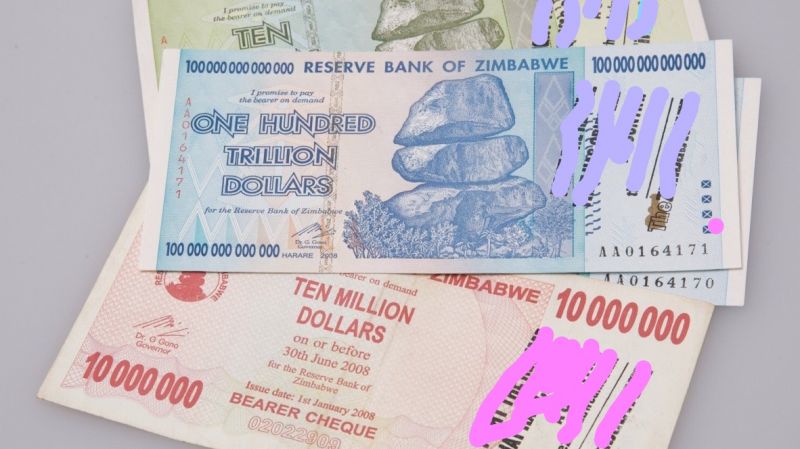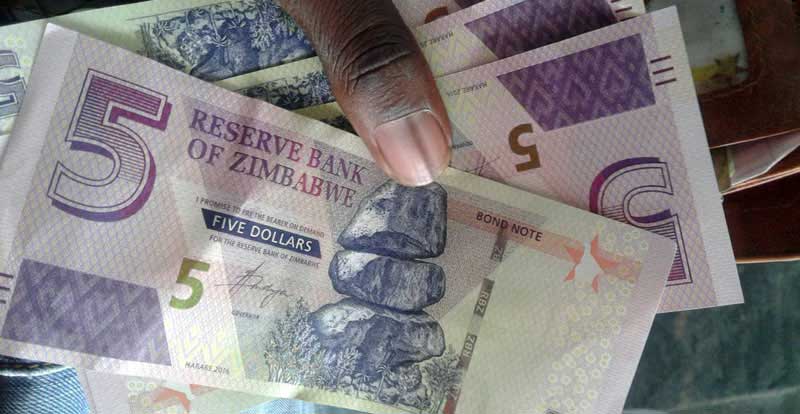Benoit Daoglio is a cool guy from France. He recently finished his studies at McGill University in Canada and he decided to tour Africa. He embarked on a trip from Nairobi in Kenya to Capetown in South Africa passing through Tanzania, Zambia, Zimbabwe, Botswana talking to tech entrepreneurs, learning and blogging about it. We met him when he was in Harare last month and here is how he interpreted what we shared and what he observed
The lack of funding for Zimbabwean companies is highly intertwined with the complicated monetary crisis faced by the country. Let’s first understand what is happening and how the situation got as is from a historical and economical background.
The Zimbabwean Monetary Crisis
The Origins
In 1997, Zimbabwe got involved in the DRC conflict to prop up the fragile Kabila’s government. This resulted in 12,000 soldiers on the ground for a cost estimated at one million US dollars per day. This war siphoned a significant amount of Zimbabwe’s foreign currency reserves. At the time, the country was starting to struggle to repay its debts and import fuel and electricity.
During that same year, Mugabe’s government eventually agreed to pay a lump-sum of 50,000 Zim Dollars (4,300 USD at the time) as well as a monthly pension of 2,000 Zim Dollars (174 USD) to all bush war veterans. This decision was to compensate for unpaid pensions since the end of the war in 1980. This war had led to the independence of Zimbabwe and opposed black guerrillas against the white-led forces of Rhodesia. This measure came at a cost of 3.5 billion Zim dollars (300 million USD), which was not accounted for in the government’s budget.
It is believed that this year was the starting point for Mugabe’s government to overuse the printing of money. Zimbabwe subsequently had its own Black Friday on 14 November 1997 when its currency tanked and lost 72% against the US dollar intraday.
The Kick — The 2000s Land Reform
When the Zimbabwean white minority government declared its independence from Britain in 1965, white Rhodesians seized most of the arable agricultural lands.The war of independence didn’t change this. Indeed, the Lancaster House Agreement enacting the independence of Zimbabwe in 1980 came with clauses protecting whites from land acquisition for ten years. It is only in 1990 that the government started a program where it acquired significant amounts of lands destined for redistribution by paying fair compensations to the farmers. However, this was not a budgetary priority for the government. In 1999, eleven million hectares were still at the hand of 4,500 farmers, mostly white.
But in 2000, Mugabe’s political party, Zanu-PF, started being in difficulty against the Movement for Demographic Change (MDC) supported by some of the white Zimbabweans. Zanu-PF therefore campaigned for the parliamentary elections on the slogan “Land is the Economy, the Economy is the Land”. After a very debatable win, Mugabe’s government encouraged land occupation and started expropriating most of the white farmers. This resulted in a significant decrease in production as the farms were divided in multiple parcels, hence eliminating economies of scales and the possibility for smallholder famers to invest in their lands. More worryingly, a lot of parcels were given to political allies and members of the governments who were not farmers and not able to sustain the previous levels of productions. This land reform metamorphosed Zimbabwe from a net maize exporter to a country receiving donated consignments of maize.
Beyond drastically deteriorating Zimbabwe’s economy, the land reform also resulted in a complete loss of support from the IMF and the World Bank towards Zimbabwe. Both institutions had been heavily supporting Zimbabwe for many years through loans and grants but decided to hold any further programs until the rule of law was restored. The heavy financial support from international organizations had ironically resulted in a government not having to fully rely on its own tax collection and hence not incentivized to be pro-business. This resulted in today’s current level of formal unemployment estimated at up to 95%, leaving room for an important untaxed informal economy. Whilst the almost-free money stream from international organizations stopped and tax collections remained low, the government did not reduce its appetite. Consequently, deficits and money printing would exponentially increase.
The Collapse
In the mid-2000s the Reserve Bank of Zimbabwe organized a mechanization scheme where they handed out tractors to farmers. This proved to be very costly, often inefficient for smallholder farmers (compacting soil, can’t bare the maintenance and operating costs) and a political move anticipating the incoming elections.
The government tried to print its way out of the mess by printing more and more money which resulted in an estimated 489 billion % annual inflation rate in 2008 according to the IMF. The government went up to printing a 100-trillion dollar bills equivalent to about only 5 USD.
People were queuing at banks to withdraw a few billions which ended up barely being sufficient to buy a loaf of bread. The pension system collapsed. All of this led to first an unofficial dollarisation of the economy which then became officially effective when the government eventually phased out the Zim Dollars and adopted a multi-currency system.

The Dollarisation and multi-currency system
In 2009, the government adopted a multi-currency system where foreign currencies such as pounds, euros, rands, dollars are accepted. This is still the system in use in 2018. USD and ZAR are the two privileged currencies with a strong preference for USD which is highly sought after.
It worked for a while as the governement was forced to plan a no-deficit budget. Prices were kept relatively normal. There was even some deflation from 2009 to 2013.
The Second Kick: 2013
Zimbabwe still struggled to increase its productivity and couldn’t sustain its population needs. Zimbabwe is not competitive on global markets, but rather a net importer of almost everything. The dollarisation hasn’t improved the situation as it actually raised the costs of exports on international markets. Moreover, the government (Zanu-PF) expenditure steadily increased year by year resulting in important budget deficits. Quickly, most of the dollars were fleeing the country for crucial imports and Zimbabwe was struck by an important shortage of USD.
The Introduction of Bond Notes

The government with no monetary sovereignty had to get creative to stop the outflow of USD. Their solution was the introduction of a series of bond coins in 2014 and eventually a large amount of bond notes in 2016. The bonds are not a currency but more of a token which is pegged to the USD. Technically, the government has decided that 1$ bond note is equivalent to 1 USD. $200M cash were put in circulation, supposedly backed by a $200 million loan by the Afreximbank. It worked quite well, today most of the cash being exchanged on a day to day basis in Zimbabwe is in bonds denominations. However, since the supply of bond notes is limited there is currently no cash in any of the ATMs in Zimbabwe, and weekly withdrawals limits are regulated by the government.

The Government back at it
Apparently the government hasn’t printed more bond notes than announced; they did learn from their mistakes in the early 2000s. However, they started paying their civil servants and contractors in digital money through wire transfers, hence creating money out of nothing. Every month, the government is pumping digital money into bank accounts.
Bond notes, which are not traded on any markets, not exchangeable, and only valid within Zimbabwe are supposed to have their value pegged to the USD. However, their intrinsic value went down. This is even truer for any digital money, also supposed to be pegged to the USD. In reality, in July 2018, for 100 USD in greenbacks, the black-market offers an equivalency of 140 bond notes and up to 180$ in digital currency in your bank account or Ecocash wallet.
Whilst prices in the formal economy are indicated in dollars, you can pay in greenbacks, bond notes, or digital money through either swipe or mobile money such as Ecocash. Most of the people therefore pay through digital currency making prices even higher in Zimbabwe if you intend to pay in USD. In the informal economy prices are multitiered. A second hand phone can be sold for 100 USD cash or 140 bond notes or 180$ through mobile money or swipe.
Another way for the government to circumvent their lack of monetary sovereignty is to issue treasury bills. No foreign investors would buy them but Zimbabwe’s banks who can’t invest in much within the country are buying the bills, lured by attractive interest rates.
The deficit for 2017 was estimated at $1.82 billion or 11.2% of GDP.
Foreign Direct Invesmtents (FDIs)?
In such a situation, there are almost no foreign investors putting their money in Zimbabwe.
Why? Most of your revenues are going to be made in bond notes which can’t be repatriated back home to your country or to the shareholders. You also can’t play the black-market game because it is first and foremost illegal, and also not sustainable on a large scale.
The few investors or foreign companies present in Zimbabwe are here for the long run. They believe that eventually the situation will get back to normal and that they will then have a competitive edge. Multinationals wanting to have a regional presence can also play the game but close to no private equity or non-African foreign investors would put their money in Zimbabwe. Even big companies, such as the airline FastJet who operates 92 flights per week in Zimbabwe, are now in a difficult situation because part of their revenues is stuck in Zimbabwe and can’t be reinvested in their regional activities.
How to get financed?
First, the bad side.
The team at Techzim in Harare pointed out to me that Zimbabwe lacks an Angel Investors community. In such a complicated market, foreign investors can’t be the one investing in seed-funding. However, they can follow wealthy Zimbabweans, who are deemed trustworthy and business aware, if they have already invested in the first rounds.
Banks, who are lacking money, do not trust startups. Hence, they often do not loan to newly launched businesses and if they do the interest rates are prohibitive.
Why a lack of local investment?
Zimbabwe, as most of Eastern Africa, lacks notorious people who made their fortune in tech. Most of the wealthy and hyper-wealty Eastern Africans got their weatlh through traditional businesses: real-estate, construction, logistics… Therefore, entrepreneurship is not considered a way to make it in the region.
If banks do decide to loan, they don’t loan enough money for startups to succeed, therefore causing their failure and a vicious circle.
Now the good side.
The biggest source of FDIs coming into Zimbabwe are remittances being sent by the large diaspora working abroad. This is you first solution: being financed by someone who knows the market and would be willing to send fresh foreign money into Zimbabwe.
Another solution is to be development oriented and benefit from the impact investing funds often supported by the philantropic arms of foreign companies (such as Facebook) or international organizations. This funding bias however results in startups solely being funded in the development space. However, a dynamic business environmment that hampers unemployement and create actual development is often led by real businesses bringing money in. Those businesses and startups are though rarely being funded today…
Nyasha Chasakara, Head of CBZ Investment Banking: Research and Sales, but also a serial entrepreneur and founder of Tech Hub Harare, with whom I have met, reminded that not all startups are like Tesla burning $7,430 per minute. If you want to launch your business in Zimbabwe and can’t rely on funding, find a business model allowing you to bootstrap your venture.
A brighter future?
With the elections held on July 30th 2018, which almost allowed opposition (MDC) to get in office, things could change. Even Emmerson Mnangagwa, the current president (Zanu-PF), officially declared elected on August 2 2018, has declared the country “open for business” and campaigned on the basis that he will attract billion of dollars worth of FDIs. Even though the results of the elections are currently resulting in important demonstrations and even deaths, whoever gets eventually officially sworn in office will be more pro-business than the Mugabe’s administration.
Zimbabwe can boast a great structural basis with one of the best literacy rate of the continent combined with a solid infrastructures network.
It’s also worth noting that the government recently launched a $25M Innovation Fund, financed by Potraz, the telco regulator. We can’t see the results yet as they have just invested in their first cohort and it hasn’t been clear on which criteria the startups were selected for funding.

6 comments
Too much history on currency, 2/3 thirds of the article!
I think startups do not get funding, not because of currency woes, (a profitable idea is profitable, regardless of the currency you are using), but because of lack of commitment. There are many pitchprenuers who have get funding here and next thing are making a pitch there and there, getting funding, but ironically their product has neither grown nor improved since 1st pitch.
As well, some af these “startups” are people seeking alternative employment since the formal job market is dry. When one member of the team finds a better opportunity, they are gone!! If it was a key member, then the startup fizzles out. If you don’t have faith in your own idea, then why should someone else.
I agree, because of high unemployment, most of the people we see pitching are just trying to put food on the table and are not committed. In S.A, although the startup scene is young, what you see is that people launching startups leave good jobs to start their companies, hence there is a lot of dedication and commitment
I personally have converted my bind to USD… I’m born and bred here… After all that I just can’t reinvest the USD here how am I going to get it out… I’m sure all those foreign investors are in the same conundrum…. How do I measure growth of my money when is based on the parallel market that can literally wipe it out…. Solution there’s plenty of local investors like me who are just sitting on dear money in the bank… We need a portal to link up with statups…. Banks are not the solution t their interest is too high… And won’t allow for growth of business… They a literally bloodsuckers…I have the money make it with my while
Very interesting! Had not thought of things that way. The same reason why people are investing on the ZSE (they can’t grow their money any other way and they can’t take it out so might as well invest in a few shares) could be the same reason for them to invest in startups if only we have an easy way for them to discover what the opportunities are etc
I want to explore this idea…
Business Start-ups require technical & commercial skills in the true sense. My experience since 1980 is that the entrepreneurs we have in Zimbabwe place too much reliance on funding rather than the quality of the business idea and the skills to back it up. This approach or model lends itself to a high import content which front loads the Start-up and becomes too dependent on foreign investors, DFIs, World Bank etc with high failure rates. The high literacy rate often talked about is a mirage because, unlike in developed countries, it does not translate into technical & commercial skills that are required to transform the raw materials or opportunities into goods and services. It is a soft platform for cheap labour for foreign employers and multinationals but a risky asset for the local employer be it in the public or private sectors. Because of the high colonial slant in the socio-economic analysis done on former colonies either by locals or foreigners, it normally requires perceptive intuition on such matters to understand the challenges.
I agree that we have a lot of educated people but very few skilled people